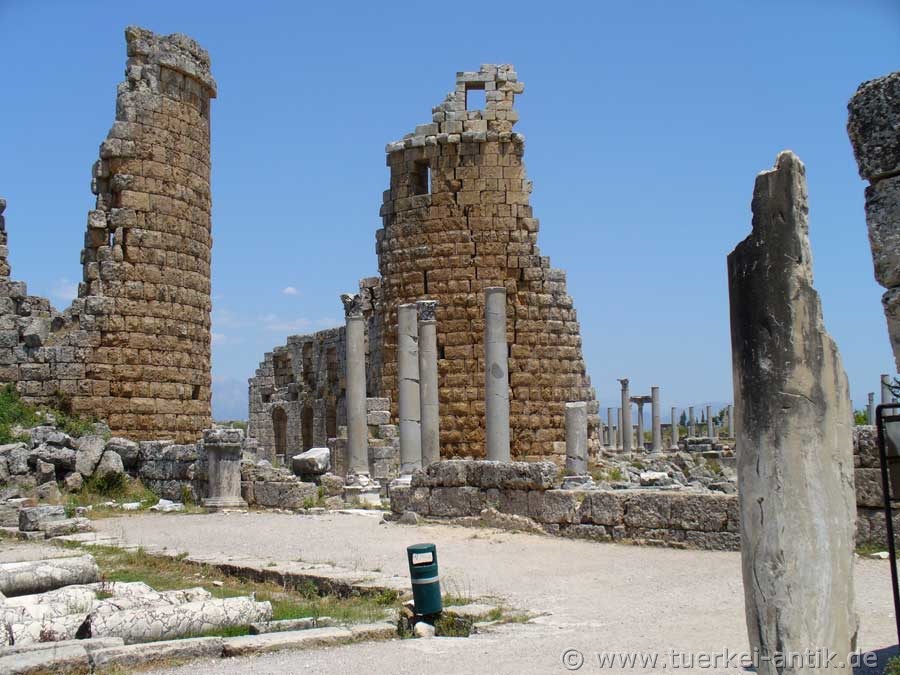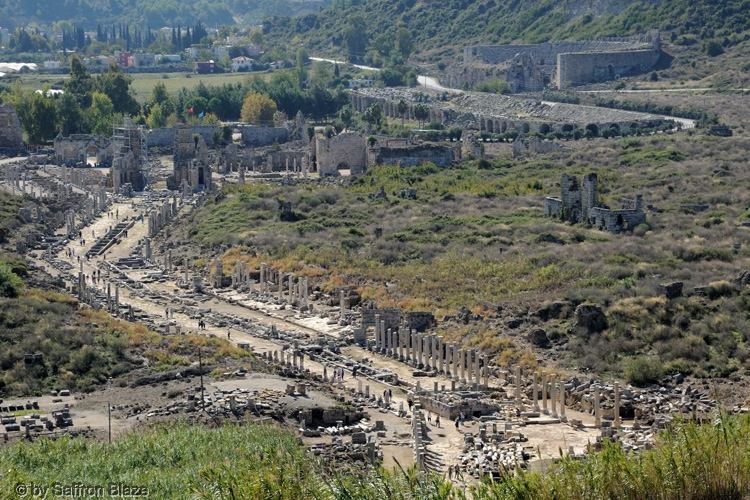 |
| Perge | |||
|
|
|
||
| The Agora | |||
|
The ancient city of Perge is of late Hellenistic-Roman origin. Although the beginnings of the city date back to the Trojan War, it was first mentioned by Alexander the Great. Perge, however, flourished only under the Romans. Christianity is documented early in Perge. The apostles Paul and Barnabas visited the city on their first missionary journey. In particular the mother of Jesus, Mary, was honoured in Perge. In Byzantine times, the city was a bishop's residence. |
|||
|
|
|||
| View of the theatre's stage house | |||
|
When you approach the ancient Perge, the first theater from the 3rd century, in which 15,000 spectators found place. |
|||
|
|
|||
| The Stadium | |||
|
On the opposite side of the street is the stadium, which today is one of the best preserved buildings of its kind in Turkey. Up to 12,000 visitors watched the chariot races and gladiator fights from the grandstands. |
|||
|
|
|||
| The Roman City Gate | |||
|
The city itself is entered through the Roman city gate. If you walk through it, the rust-red, half-decayed towers of the Hellenistic city gate immediately catch the visitor's eye. |
|||
|
|
|||
| The Hellenistic city gate in front of the stabilization of the right tower by a massive steel frame | |||
|
|
|||
|
The courtyard of the Hellenistic city gate |
|||
|
|
|||
|
Had one had passed the gate between the two mighty towers at that time, one found oneself in a splendidly equipped, horseshoe-shaped inner courtyard. In the wall niches, statues of gods, the legendary city founders and not least Plancia Magna, the daughter of the Roman senator, proconsul Marcus Plancius Varus, stood on inscribed bases. Plancia Magna was a generous patron of the city. In 120 AD she had also donated the statues for the city gate. |
|||
|
|
|||
|
|
|||
|
Still impressive today, the Agora of Perge |
|||
|
|
|||
|
The Agora, the central market square, is located to the right of the Hellenistic city gate. Surrounded by porticoes, the 52 x 52 meter square was the centre of social life. Exactly in the middle of the square was the round temple of the goddess of luck Tyche. We find the same e.g. - restored in 2012 - on the trade agora of Side. |
|||
|
|
|||
|
|
|||
|
View of the city from the Acropolis |
|||
|
|
|||
|
A 20 metre wide colonnade road lined by numerous columns led across the city to the Nymphaeum and the Acropolis. In the middle there was a 2 meter wide canal, in which water ran in cascades from the nymphaeum at the Acropolis to the city gate and from there to the large nymphaeum at the city gate was led. |
|||
|
|
|||
|
|
|||
|
The nymphaeum at the Acropolis with the statue of the river god Kestros |
|||
|
|
|||
|
The ancient Perge lies approx. 60 km west of the popular holiday resort Side and approx. 18 km east of Antalya, and approx. 10 km from Antalya airport. It is very easy to reach via the well-developed D400 national road leading from Antalya to Alanya. In the village of Aksu the access road coming from Side turns right. The exit is well signposted and not to be missed. In 2015, on the occasion of the Expo Antalya 2016, an overpass over the departure was built. Leave the D400 in the direction of Aksu and turn left or right below the overpass. |
|||
| Photos: @chim | |||
| Translation aid: www.DeepL.com/Translator | |||
| Source: Wikipedia and others | |||
|
|
|||



